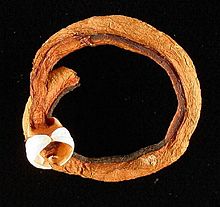
Back دودة السفن Arabic Teredinidae Bulgarian Teredínids Catalan Teredinidae CEB Pæleorme Danish Schiffsbohrmuscheln German Teredinidae Spanish Teredinidae French Hajóféreg Hungarian Նավաորդ Armenian
This article has multiple issues. Please help improve it or discuss these issues on the talk page. (Learn how and when to remove these template messages)
|
| Shipworm | |
|---|---|

| |
| This dried specimen of Teredo navalis, and the calcareous tunnel that originally surrounded it and curled into a circle during preservation, were extracted from the wood of a ship. The two valves of the shell are the white structures at the anterior end; they are used to dig the tunnel in the wood. | |
| Scientific classification | |
| Domain: | Eukaryota |
| Kingdom: | Animalia |
| Phylum: | Mollusca |
| Class: | Bivalvia |
| Superorder: | Imparidentia |
| Order: | Myida |
| Superfamily: | Pholadoidea |
| Family: | Teredinidae Rafinesque, 1815 |
| Genera | |
|
See text | |
The shipworms, also called Teredo worms or simply Teredo (from Ancient Greek τερηδών (terēdṓn) 'wood-worm', via Latin terēdō), are marine bivalve molluscs in the family Teredinidae, a group of saltwater clams with long, soft, naked bodies. They are notorious for boring into (and commonly eventually destroying) wood that is immersed in seawater, including such structures as wooden piers, docks, and ships; they drill passages by means of a pair of very small shells ("valves") borne at one end, with which they rasp their way through. They are sometimes called "termites of the sea".[1] Carl Linnaeus assigned the common name Teredo to the best-known genus of shipworms in the 10th edition of his taxonomic magnum opus, Systema Naturæ (1758).
- ^ Garcia, Sierra (2021-12-24). "How "Termites of the Sea" Have Shaped Maritime Technology". JSTOR Daily. Retrieved 2022-05-01.
© MMXXIII Rich X Search. We shall prevail. All rights reserved. Rich X Search